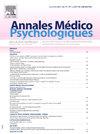Du catégoriel au dimensionnel : description et illustration clinique pour favoriser une transition harmonieuse dans la conceptualisation des troubles de la personnalité
IF 0.5
4区 医学
Q4 PSYCHIATRY
引用次数: 0
Abstract
Introduction
Research and clinical practice in the field of personality disorders (PD) have taken a major and decisive turn in recent years with the publication of the Alternative Model of Personality Disorders (AMPD) in the fifth edition of the Diagnostic and Statistical Manual of Mental Disorders and with the introduction of a purely dimensional model in the latest edition of the International Classification of Diseases (ICD-11). Along with the general criteria of PD described in the previous versions of the DSM, the AMPD defines personality pathology based on two main dimensional criteria. The first one refers to the severity of personality dysfunction in the spheres of self (including Identity and Self-direction elements) and interpersonal relationships (referring to Empathy and Intimacy elements). Each element can be classified in a severity level ranging from 0 (few or no alteration) to 4 (extreme alteration). The second criterion describes five pathological domains of personality, broken down into 25 pathological facets: Negative affectivity, Detachment, Antagonism, Disinhibition, and Psychoticism. To diagnose a PD in the AMPD model, a person must present a moderate alteration (level 2) in at least two elements and a significant elevation in at least one pathological facet. The AMPD is considered a hybrid model as categorical diagnosis of six PDs (antisocial, avoidant, borderline, narcissistic, obsessive-compulsive, schizotypal) can be made using algorithms including specific pathological facets for each PD. For its part, the model developed in the ICD-11 relies on a general criterion of personality dysfunction to establish the presence and intensity of PD based on a five-point severity continuum: (a) no personality disorder, (b) presence of personality difficulties (without a clear personality disorder), (c) mild personality disorder, (d) moderate personality disorder, or (e) severe personality disorder. Optionally, the clinician can also indicate the presence of five trait domains qualifiers, akin to those found in the AMPD: Negative affectivity, Detachment, Dissociality, Disinhibition, and Anankastia. A specifier for borderline patterns can also be applied. Despite being relatively recent, these models have already generated a lot of interest in the PD research community; however, there are only limited published works devoted to these models intended for French-speaking researchers and clinicians.
Objective
The aim of this article is to provide a guide for French-speaking researchers and clinicians, to promote a smooth transition between the traditional categorical approach and the two emerging dimensional models of PD described above.
Method
After a brief introduction to the two dimensional models and their respective scoring procedures for the diagnosis of PD, the similarities and distinctions between categorical PD diagnoses and these new dimensional models will be outlined. A case study will illustrate the clinical application of the dimensional models in comparison with the categorical approach.
Conclusion
Despite a few limitations, the clinical utility of the two emerging dimensional models appears promising on several fronts, including treatment planning and course/outcome assessment, and various tools are available to clinicians to promote a smooth and seamless transition to these diagnostic approaches.
从范畴到维度:描述和临床说明,以促进人格障碍概念化的和谐过渡
近年来,随着《精神疾病诊断与统计手册》第五版中人格障碍替代模型(AMPD)的出版,以及最新版《国际疾病分类》(ICD-11)中纯维度模型的引入,人格障碍(PD)领域的研究和临床实践取得了重大而决定性的转变。与DSM之前版本中描述的PD的一般标准一样,AMPD根据两个主要维度标准定义了人格病理学。第一个是指人格功能障碍在自我(包括认同和自我导向因素)和人际关系(包括共情和亲密因素)方面的严重程度。每个元素都可以被划分为一个严重级别,从0(很少或没有变化)到4(极端变化)。第二个标准描述了人格的五个病理领域,分为25个病理方面:消极情感、超然、对抗、去抑制和精神病。要在AMPD模型中诊断PD,患者必须在至少两个要素中表现出中度改变(2级),并在至少一个病理方面表现出显著升高。AMPD被认为是一种混合模型,因为可以使用包括每种PD的特定病理方面的算法对六种PD(反社会、回避型、边缘型、自恋型、强迫症、分裂型)进行分类诊断。就其本身而言,ICD-11中开发的模型依赖于人格功能障碍的一般标准,根据五个严重程度连续体来确定PD的存在和强度:(a)无人格障碍,(b)存在人格困难(没有明显的人格障碍),(c)轻度人格障碍,(d)中度人格障碍,或(e)严重人格障碍。选择性地,临床医生也可以指出五个特征域限定符的存在,类似于在AMPD中发现的特征域限定符:消极情感、脱离、分离、去抑制和无抑郁。还可以应用边界模式的说明符。尽管这些模型相对较新,但已经引起了PD研究界的极大兴趣;然而,针对法语研究人员和临床医生的这些模型的出版作品有限。目的本文旨在为法语研究人员和临床医生提供指导,以促进传统的分类方法与上述两种新兴的PD维度模型之间的顺利过渡。方法在简要介绍PD诊断的两种维度模型及其各自的评分程序后,概述PD分类诊断与这些新维度模型之间的异同。一个案例研究将说明维度模型与分类方法的临床应用。尽管存在一些局限性,但这两个新兴维度模型在治疗计划和过程/结果评估等方面的临床应用前景广阔,临床医生可以使用各种工具来促进向这些诊断方法的顺利无缝过渡。
本文章由计算机程序翻译,如有差异,请以英文原文为准。
求助全文
约1分钟内获得全文
求助全文
来源期刊

Annales medico-psychologiques
医学-精神病学
CiteScore
1.30
自引率
33.30%
发文量
196
审稿时长
4-8 weeks
期刊介绍:
The Annales Médico-Psychologiques is a peer-reviewed medical journal covering the field of psychiatry. Articles are published in French or in English. The journal was established in 1843 and is published by Elsevier on behalf of the Société Médico-Psychologique.
The journal publishes 10 times a year original articles covering biological, genetic, psychological, forensic and cultural issues relevant to the diagnosis and treatment of mental illness, as well as peer reviewed articles that have been presented and discussed during meetings of the Société Médico-Psychologique.To report on the major currents of thought of contemporary psychiatry, and to publish clinical and biological research of international standard, these are the aims of the Annales Médico-Psychologiques.
 求助内容:
求助内容: 应助结果提醒方式:
应助结果提醒方式:


